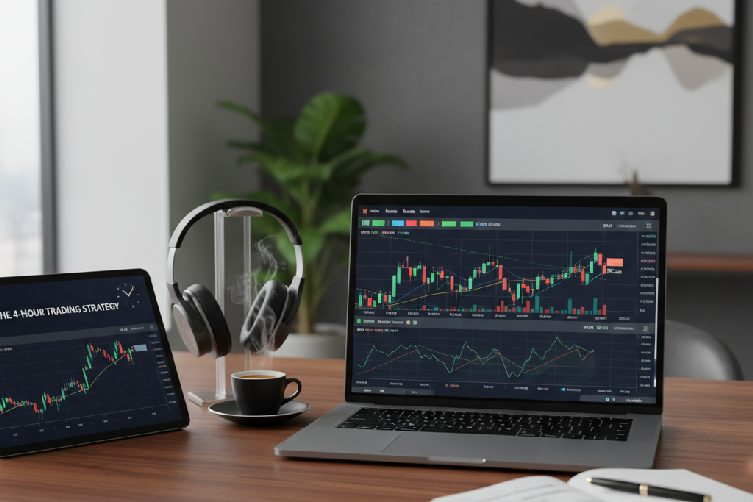The Ultimate 4-Hour Trading Strategy

Are you tired of being glued to your trading screen for endless hours, constantly trying to catch every market movement? The 4-hour forex trading strategy could be your solution, offering a path to financial freedom and a more balanced lifestyle. This powerful approach allows you to capitalize on significant market trends, freeing up your time for other important pursuits.
In this comprehensive guide, we’ll delve into the world of 4-hour forex trading. We’ll reveal the secrets professional traders use to consistently generate profits. Whether you’re a beginner starting your forex journey or an experienced trader looking to refine your strategy, this article will provide the knowledge and tools needed to succeed on the FXNX platform.
What is the 4-Hour Forex Trading Strategy?
The 4-hour forex trading strategy is a popular method that involves analyzing and trading currency pairs using 4-hour candlestick charts. This approach offers a great balance between short-term and long-term trading, enabling traders to capture substantial price movements while avoiding the noise and stress often associated with day trading.
By focusing on the 4-hour timeframe, traders can identify key trends, support and resistance levels, and potential entry and exit points with greater clarity and precision.
Why Choose the 4-Hour Timeframe?
- Balanced perspective: The 4-hour chart provides a comprehensive view of market trends without getting lost in minor fluctuations.
- Reduced stress: With fewer trades to manage, you can make more informed decisions and avoid the burnout often linked to day trading.
- Improved work-life balance: This strategy allows you to maintain a regular job or pursue other interests while actively participating in the forex market.
- Higher-quality setups: The 4-hour timeframe often produces more reliable trading signals, potentially leading to more profitable trades.
- Lower transaction costs: Fewer trades typically mean reduced spreads and commissions, ultimately improving your overall profitability.
Key Components of a Successful 4-Hour Forex Trading Strategy
When developing a price action-based 4-hour forex trading strategy, it’s crucial to focus on the following key components:
1. Chart Analysis
Chart analysis forms the backbone of any effective price action trading strategy. By studying raw price movements on your charts, you can identify potential entry and exit points for your trades. Key elements to focus on include:
- Support and resistance levels
- Trend lines and channels
- Chart patterns (e.g., head and shoulders, triangles, flags)
- Candlestick patterns (e.g., engulfing patterns, doji, pin bars)
2. Market Structure
Understanding market structure is crucial for effective price action trading. This involves identifying:
- Higher highs and higher lows in uptrends
- Lower highs and lower lows in downtrends
- Ranging markets and consolidation periods
- Key swing points and market pivots
By recognizing these structures, you can better anticipate potential price movements and identify optimal entry and exit points.

3. Price Action Patterns
Familiarize yourself with common price action patterns that occur on the 4-hour timeframe. These may include:
- Inside bars
- Outside bars
- Fakey patterns
- Pin bars (bullish and bearish)
- Engulfing patterns
These patterns can provide valuable insights into potential trend continuations or reversals.
4. Volume Analysis
While not a direct form of price action, volume can provide important context to price movements. On the 4-hour chart, look for:
- Increasing volume on breakouts
- Decreasing volume during consolidations
- Volume divergences (e.g., price moving up on decreasing volume, or vice versa)
5. Multiple Timeframe Analysis
Even while focusing on the 4-hour chart, it’s beneficial to incorporate analysis from other timeframes:
- Higher timeframes (daily, weekly) for overall trend direction
- Lower timeframes (1-hour, 30-minute) for fine-tuning entries and exits
This multi-timeframe approach can help confirm your analysis and improve your trading decisions, leveraging FXNX’s advanced tools.
6. Risk Management
Effective risk management remains crucial in price action trading:
- Set clear stop-loss levels based on recent swing highs/lows or key support/resistance levels.
- Use proper position sizing, risking no more than 1-2% of your account on a single trade.
- Maintain a favorable risk-reward ratio, aiming for at least 1:2.
- Consider scaling in and out of positions to manage risk and lock in profits.
7. Trading Plan and Journal
Develop a comprehensive trading plan that outlines your price action strategy, risk management rules, and trading goals. Consistently maintain a trading journal to track your performance, identify areas for improvement, and refine your approach over time.
8. Fundamental Awareness
While price action trading primarily focuses on chart analysis, it’s important to stay aware of key fundamental factors that can impact currency movements. Keep an eye on:
- Major economic releases
- Central bank announcements
Paying attention to these external factors can provide additional conviction for FXNX traders.

 This simplification allows traders to focus on the most meaningful trends and patterns within the forex market.
This simplification allows traders to focus on the most meaningful trends and patterns within the forex market.


